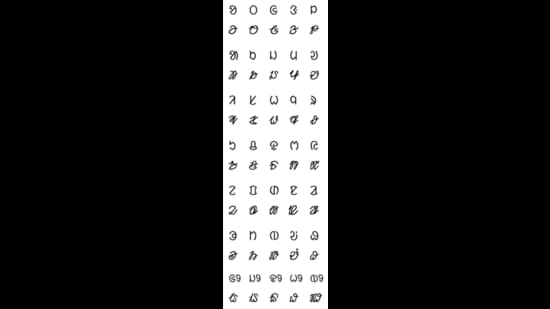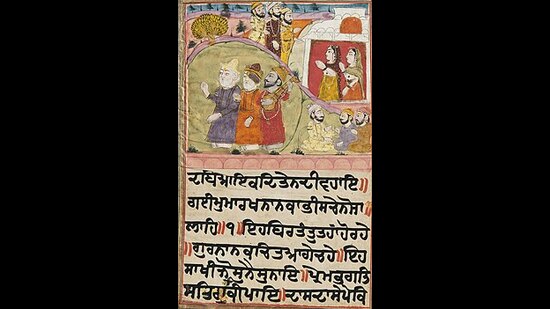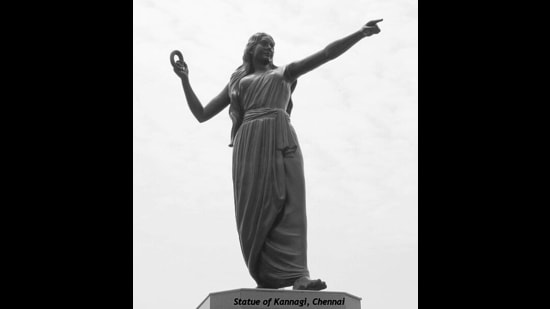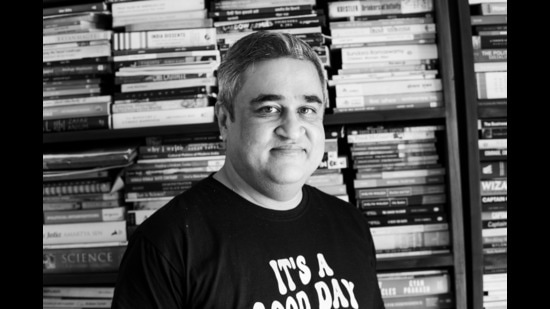Crossover episode: 10 Indian languages and how they evolved
Their telltale roots cannot be erased, even as they travel with their speakers and histories become blurred.
How does Brahui, spoken today in parts of Pakistan, for instance, have shared roots with Tamil and Malayalam? How, and when, did Tamil, Telugu and Kannada grow out of Proto-Dravidian? Where, geographically, did Proto-Dravidian originate?
The Harappan civilisation could be a shared link. Does this mean that a small group of Harappans stayed? Never left? And held on to their language?
Or did the Brahui-speakers move north, from southern India, all the way to Balochistan, at a much later date?
Among the other ancient mysteries (though there are some answers here) is Prakrit. How did this collection of vernacular Middle-Indo-Aryan languages come to be so widespread across the subcontinent for about 1,000 years, from the 3rd century BCE to the 8th century CE? How is it that traces of it remain, in Marathi, Punjabi, Telugu, Hindi?
These deliciously tangled threads have intrigued Karthik Venkatesh for years.
Karthik Venkatesh, author and executive editor at Penguin Random House India.
His own history with Indian languages added to the intrigue. The executive editor at Penguin Random House India was born into a Palakkad family then living in Kolkata, raised primarily in Bengaluru. He went on to live in Delhi, Bathinda and Kochi. He speaks fluent Kannada and Tamil, some Malayalam and a bit of Dakhini. And, of course, Hindi and Punjabi. “My father grew up in north India, so Hindi was common in our household. Later, while running a school with my wife in Bathinda, I learnt to read, write and speak Punjabi.”
For Indians, multilingualism comes so naturally that we forget what a strange and wonderful thing it is, he adds, laughing.
This year, Venkatesh distilled about eight years of research in this field, into a book titled 10 Indian Languages and How They Came to Be (Duckbill).
 The book dips into a mix of familiar and less-familiar tongues, in an attempt to spotlight certain myths.
The book dips into a mix of familiar and less-familiar tongues, in an attempt to spotlight certain myths.
The book dips into a mix of familiar and less-familiar tongues, in an attempt to spotlight certain myths. “Indian languages are fluid; they are still constantly influencing each other,” he says.
The main thing to remember about languages is that there is really no such thing as “pure”, adds linguist Abhishek Avtans, a lecturer at Leiden University, chuckling.
What are the twists and bends in the road they’d like you to know about? Take a tour.
.
Santali
Movement and migration are central to Santali, the language of the Santals, India’s largest tribe.
The history of those ancient migrations is preserved in terms such as “hihiri pihiri”, “khoj kaman”, “harata” and “sasangbeda”, which represent the places they came from, in the distant past, as their ancestors travelled from southeast Asia and settled in this part of the subcontinent.
Their origin stories interpret these journeys interestingly too. The Santali origin myth, for instance, speaks of two cycles of creation. The sun, represented by a giant horse, destroyed the world as it was first created. So the creator made a new world, in another place (hihiri pihiri).
The language evolved as the tribe moved. Research has established, for instance, that the Munda languages of eastern and central India — the most popular of which is Santali — originated on the east coast, after their Austroasiatic precursor arrived there from South-East Asia, via a maritime route, about 4,000 years ago.
In a 2019 paper, the Australian linguist Paul Sidwell notes that “a small Austroasiatic population then brought pre-Proto-Munda by means of a maritime route across the Bay of Bengal to the Mahanadi Delta region”.
For millennia, this language and culture survived through a hardy oral tradition. But a dedicated script, developed in 1925, has helped.
The script is called Ol Chiki (ol for “writing” and chiki for “learning”) and was created by Raghunath Murmu (1905-1982), a writer and scholar from Mayurbhanj in Odisha. It is the most popular of at least 14 scripts invented for writing Santali, says Avtans.
 The Ol Chiki script uses symbols drawn from nature: sickle, bee, river, hill. (Wikimedia Commons)
The Ol Chiki script uses symbols drawn from nature: sickle, bee, river, hill. (Wikimedia Commons)
Ol Chiki contains 24 consonants and six vowels, which represent sounds unique to this tongue. (There are many such sounds, which is why earlier attempts to use the Bangla, Devanagari, Odia and Roman scripts proved ineffective.)
The symbols are drawn from nature: hill, river, tree, plough, sickle. Together, this makes for an unusual alphabet. The sound “unn”, for instance, is represented by the squiggle of a flying bee (unn is also, in Santali, the sound of the bee).
The Ol Chiki script has made it easier to study and preserve this language, says Venkatesh.
This is good news for the estimated 7.3 million Santali speakers, spread primarily across Jharkhand, West Bengal, Odisha and Bihar. Meanwhile, in another bit of good news, a fair amount of folk lore is now being accurately preserved too.
.
Khasi
The Khasis are believed to have journeyed across South-East Asia to enter the subcontinent via Myanmar, and settle in Meghalaya, about 12,000 years ago.
There are still echoes of Khmer, the language of present-day Cambodia, in Khasi. Tiger, for instance, is khla in both tongues. New is “thymme” or “thymmai” in Khasi and “thmei” or “thmai” in Khmer.
The Indian language, interestingly, still has no independent script. Written Khasi uses Bangla or the Roman script, with a few letters replaced to represent required sounds.
Poetry plays a powerful role in Khasi’s largely oral tradition. Customs and laws are preserved in verse and song too.
A popular poetic form is the ki phawar or couplet. There are ki phawars for every major event, including archery contests, festivals and funeral rites.
Since the 19th century, Khasi writers have been publishing books on the tribe’s religion and its legends. Collections of poetry, and children’s tales based on the community’s lore, are popular themes too.
A popular Khasi poet of the modern age is U Soso Tham (1873-1940), who has been hailed for his secular, evocative verse. Below is an excerpt from Ki Symboh Ksiar (Grains of Gold), as translated by Janet Hujon, a Khasi writer from Shillong.
We scour the world in search of light,
Know not the light within our land,
How long ago far back in time,
Our ancients did new worlds create…
Among the Stars, the Sun and Moon,
On hills and forests, spirits roamed,
Man and Beast, the Tiger, Thlen [a giant mythical snake],
United by a common tongue.
.
Kokborok
Kokborok, literally language of the Borok people, is the official language of Tripura.
It has close ties with the Bodo and Dimasa languages of Assam, and with Garo, spoken in Meghalaya.
Kokborok, unusually, started out with a script, which faded over time, and eventually disappeared. Traces of Koloma survive in some of the carvings on ancient temples in Tripura, dating to at least the 1st century CE.
The language is now written mainly in Bangla. The oldest texts in this language survive in the form of ancient Bangla and Sanskrit translations too.
These include the Rajratnakar, a chronicle of the kings of Tripura, likely written by a head priest. A 14th century Bangla version, called Rajmala, survives, and merges fact and fiction in beautiful ways, tracing a line of real kings backwards through centuries, into an era of mythical, deified beings.
The Rajmala tells of rulers descended from a “lunar dynasty”. By the seventh generation, a king named Druhya sails along the Kapila river. The chronicle then traces his lineage to Chhengthung Fa or Maha Manikya, a Twipra or Tripura king from the 1400s.
“According to the Rajmala, Chhengthung Fa fought and won a battle against a ruler of Bengal and took the title Maha Manikya,” Venkatesh writes.
The Manikya kings appear to have favoured Bangla, perhaps a means of maintaining control and keeping the peace. But, as a result, from the 15th century on, written works in Kokborok became rare.
The language continued to be spoken by the eight tribes of the Borok people. A few centuries on, in the 1800s, it saw a dramatic revival. Amid a boom in publishing and British scholarship of Indian languages, written works began to appear, including magazines and periodicals.
Kokborok was declared the official language of Tripura in 1979. It is spoken by an estimated eight lakh people. The script remains modified Bangla or modified Roman.
.
Manipuri
This is a language that has suffered great loss.
In the 18th century, a Vaishnav king named Pamheiba declared Vaishnavism the state religion, and began to destroy non-Vaishnavite shrines and literature. Among the things he is said to have set on fire were ancient Meitei manuscripts that had survived thousands of years.
The leaf manuscripts, called puyas, contained theories about the stars, epic poems, historical tracts, studies of geography, tales of battle, rain songs, histories of rewards handed out for the capture of enemy soldiers, and for grand trophies during a hunt; even the tale of the origin of the god Sanamahi himself, and notes on his activities.
The loss was felt so deeply that it is still mourned every year, with a day in January observed as a period of mourning for Puya Meithaba, or the burning of the puyas.
The language, nonetheless, has survived and thrived. Its script has reinvented itself over time.
Artefacts such as copper-plate inscriptions and coins dating to the 1st century CE bear the curly Kok Sam Lei script. Bangla became the script of choice in the 18th and 19th centuries, during the rule of Vaishnav kings.
By the 20th century, linguists in the state were campaigning for a modern Manipuri script, and Mayek was born.
It is similar to the ancient Kok Sam Lei, but with the addition of new letters to represent more sounds. All the state’s newspapers now use this script. The Bengali-Assamese script remains popular too, says Avtans.
 A postage stamp depicting the Meitei game Sagol Kangjei, which inspired the British game polo. (Wikimedia Commons)
A postage stamp depicting the Meitei game Sagol Kangjei, which inspired the British game polo. (Wikimedia Commons)
Meanwhile, one thing survived the burning of the puyas: A record of a popular game. A Meitei text from 33 CE paints a picture of a sport called Sangol Kangjei (Horse Hockey), famously invented in this region, played by princes on horseback.
It is polo.
.
Nagamese
Over the centuries, Nagamese has been born from bits of Naga languages, Assamese, Bangla and English.
It acts as a crucial link between Naga tribes, and is spoken by nearly everyone in the state, but it is not officially recognised.
Interestingly, it is the Naga people who seem happy to leave things as they are.
Official recognition has been opposed on the grounds that each tribe recognises its own language as its mother tongue. (These tongues include Ao, Chang, Lotha, Phom.)
The tribes’ languages are nuanced and complex. Nagamese cannot replace them, Nagas say. But it can serve as a link, a language of the streets, the marketplaces and the everyday. The theory is that this is how it was born — as a link language between the Naga and the Ahom kings of Assam, primarily to facilitate trade.
The state’s official language is English.
.
Marathi
Marathi evolved from Maharashtri Prakrit, becoming popular in the 11th century, says Karthik Venkatesh, author of 10 Indian Languages and How They Came to Be.
The earliest trace of Maharashtri Prakrit is a 1st century BCE inscription in Naneghat, in the Western Ghats, recording details of the Satavahana dynasty (2nd century BCE to 3rd century CE).
The poet-saint Dnyaneshwar is generally considered the first great writer in Marathi. His Dnyaneshwari (1290), an interpretation of the Bhagavad Gita, is still in print and still studied.
Between the 17th and 19th centuries, with the rise of the Maratha empire, the language spread far and fast: to Thanjavur, Indore, Vadodara, Gwalior, Jhansi. It is a syncretic tongue that shares words with its neighbours, perhaps most notably with the Konkani spoken in Goa. “Saang” is both Konkani and Marathi for “say”; “aayi” is the shared word for mother (a word shared with Kannada too).
The language united its people during the Samyukta Maharashtra movement for statehood. It has been the language of poets, rebels, reformers, and of some of India’s finest literature, particularly on life in the margins.
Delve into the collection of stories by Baburao Bagul (1930-2008), Jevha Mi Jat Chorali Hoti (When I Concealed My Caste), for a sampling of life as a Dalit a century ago. For something more contemporary, try Cobalt Blue (2013), about a brother and sister who both fall in love with their family’s paying guest. Written by Sachin Kundalkar, translated by Jerry Pinto.
.
Punjabi
Like Marathi, Punjabi emerged from a version of Prakrit. The earliest traces of it can be found in Shaivite writings from the 8th century CE.
Four centuries later, the Chishti Sufi saint Baba Farid (1173-1266) would compose hundreds of poems in Punjabi, many of which are part of the Sikh holy text, the Guru Granth Sahib. He is credited with developing Punjabi as a literary tongue, by bypassing Sanskrit, Persian and Arabic and opting to use this language instead.
Guru Nanak (1469-1539), the founder of Sikhism and the first of its 10 Gurus, and his followers would all continue to use the language — which developed a rich oral tradition of love stories, myths and poems alongside.
 An illustrated folio from an account of Guru Nanak’s life and teachings. (Wikimedia Commons)
An illustrated folio from an account of Guru Nanak’s life and teachings. (Wikimedia Commons)
At Independence, Punjabi battled to be given its due standing alongside Hindi in the region, but a movement led by the Shiromani Akali Dal finally prevailed, and the state of Punjab was created in 1966.
In an evocative example of the power of languages to unite, most Hindi-speakers today speak at least a little Punjabi, because it is, in many ways, India’s language of love. It would be hard to create popular music, film music or indeed rap in northern India, without at least a smattering of this tongue.
.
Tamil
 A leaf from the Sangam-era grammar text Tolkappiyam, written c. 200 BCE. (Wikimedia Commons)
A leaf from the Sangam-era grammar text Tolkappiyam, written c. 200 BCE. (Wikimedia Commons)
A lot of what we know about the earliest surviving texts in Tamil, we know because of one man. He is called Tamil Thatha (Grandfather).
UV Swaminatha Iyer (1855-1942), a scholar and teacher of the language, considered himself an expert on it until a casual debate in 1880. His challenger was a judge named Ramaswami Mudaliar.
Have you heard of the Silappadikaram (Tale of the Anklet), he asked the teacher. Iyer had never heard of the epic poem about ill-fated love, composed between 200 and 500 BCE.
He knew that the language went at least as far back as the 2nd century BCE, but, as later archaeological evidence would show, there were centuries of lost work before that, much of it of a non-religious nature.
Iyer suspected that some of these would have been preserved anyway, in the oldest families and in temples, perhaps in monasteries and educational institutes, and he went in search of these. Sure enough, he found manuscripts forgotten in lofts and storerooms, wrapped in matting and set aside in trunks.
He ended up rediscovering and publishing about 100 works of Sangam-era literature, across five decades.
There were ancient folios on grammar, poems on war and love, chronicles of kings and court politics.
 A statue of Kannagi, heroine of the Tamil epic poem Silappadikaram. (Wikimedia Commons)
A statue of Kannagi, heroine of the Tamil epic poem Silappadikaram. (Wikimedia Commons)
To trace how far Tamil has spread, one may look at how it flourished as the language of the mighty Chola and Chera dynasties, from the 10th century onwards. There is even a bilingual Tamil-Chinese inscription in the port town of Quanzhou in China, dating to 1281.
“The Tamil identity is intrinsically tied to the language and its history, and is perhaps one of the most powerful, assertive linguistic identities that have been shaped in India,” says linguist Avtans.
There are about 69 million Tamil speakers in the world today.
.
Telugu
The roots of Telugu are wrapped in an interesting myth about an 11th-century poet, a lost work, and a dream about translating that lost work into a new tongue. Whether inspired by the dream or not, the poet Kakunuri Appakavi laid down one of the earliest known grammatical works on Telugu, in 1656 CE.
While the myth is evocative, Telugu goes a lot further back than the 11th or 17th centuries.
 An artefact bearing characters from ancient Telugu, at the World Telugu Museum in Visakhapatnam. (Wikimedia Commons)
An artefact bearing characters from ancient Telugu, at the World Telugu Museum in Visakhapatnam. (Wikimedia Commons)
Prakrit inscriptions mention this language as far back as 400 BCE. It is likely that it started taking shape at this time, from the group of tongues known as Proto-Dravidian. Telugu flourished under royal patronage from the 14th century on.
At Independence, there was a strong demand for a separate linguistic state for Telugu-speakers, but it was said that they were too spread out to qualify, with pockets across a north-south swathe from Hyderabad to Chennai.
The Indian freedom fighter Potti Sriramulu went on a 56-day fast in protest, demanding the creation of Andhra Pradesh. His death during that fast, in 1952, aged 51, would be a turning point. Prime minister Jawaharlal Nehru announced the creation of Andhra Pradesh, India’s first state formed along linguistic lines. Others would follow.
Hindi
Hindi, in its earliest form, can be traced to at least the 7th century CE. It was born of the gradual blend of Sanskrit and forms of Prakrit.
As far back as the 12th century, Chand Bardai, court poet to Prithviraj Chauhan, was writing what is now one of the earliest surviving Hindi works, the Prithiviraj Raso.
Then Chauhan would be defeated by Muhammad Ghori. Centuries of Mughal rule would follow. And Hindi would find itself conflated, lending to and borrowing from another evolving tongue: Urdu.
Both would borrow widely from Sanskrit and Persian, as well as Braj, Awadhi, Bhojpuri and Khari Boli, among others. They would draw from Arabic and Turkish too. The words bazaar (market) and safar (journey), for instance, are Persian; kitab (book) is Arabic.
When attempts began to standardise these languages, Hindi leaned towards Sanskrit and adopted the Devanagari script. Urdu leaned towards Persian and adopted a modified version of the Perso-Arabic script.
“The Serampore Press was an important influence in this process. They established publishing houses throughout north India to publish Christian religious literature directed at Hindus and Muslims. They used a Sanskritized language and the Nagari script for literature targeting Hindus and a Persianized language and the Perso-Arabic script for Muslims,” writes Venkatesh.
“Hindi is still constantly defining and redefining itself. Even today, there is an attempt to redefine ‘shudhh’ Hindi as a more Sanskritised version,” says Mohini Gupta, a researcher with the Faculty of Asian and Middle Eastern Studies at Mansfield College, University of Oxford, focusing on Hindi, Hinglish and language politics. “The removal of Urdu words from the language becomes a parallel process in this redefinition.”
Of all of India’s many rich linguistic traditions, it would eventually be Hindi that unified the country during the fight for independence. There isn’t an Indian that doesn’t know at least some Hindi (it is, after all, the language of the national anthem).
And it is a rare Indian who doesn’t look around with a smile when the warmth of it washes over them abroad.
Images are for reference only.Images and contents gathered automatic from google or 3rd party sources.All rights on the images and contents are with their legal original owners.


Comments are closed, but trackbacks and pingbacks are open.